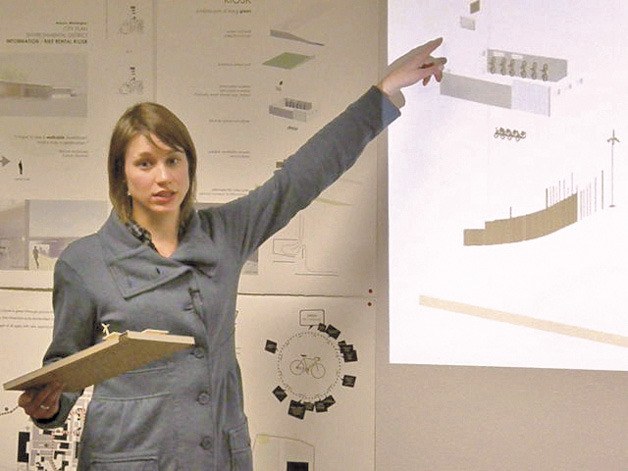Auburn is the site of many great events each year, including the Veterans Day Parade and the July 4 Kids Parade.
Starting in April 2012, it may add a yearly Earth Day bicycle parade to the mix. The event would follow a 10-kilometer route marked by local businesses taking steps to reduce their carbon footprints.
Marisa Hagney, 21, a fourth-year architecture student at Washington State University, thought of the idea as one of 37 architecture and engineering students involved in the university’s Integrated Design Experience or IDex project. At the behest of Auburn City Councilman Rich Wagner and WSU Professor Dr. Michael Wolcott, the students worked out green solutions to an old problem — how to keep contaminants such as oil and grease from slipping off of Auburn’s streets and into the environment.
Recently, Hagney, using copious maps and diagrams, presented her ideas to the City’s Bicycle Task Force.
“What this 10K parade would do is recognize new green businesses, new retrofits to buildings, expose people to new places that have decreased their levels of carbon output,” Hagney said. “The big idea is to transcend the physical and economic barriers of what Auburn offers right now … I would also like to expose Auburn residents and visitors to new areas in Auburn they haven’t explored yet.”
Wagner, who has collaborated with Wolcott, director of the university’s Institute for Sustainable Design, on several engineering and architectural projects involving the future Auburn Environmental Park, called the bike parade “a distinct possibility.”
“That’s why I wanted the Bicycle Task Force to look at it,” Wagner said. “Even with things like the Veterans Parade, there are community groups that really make them happen. I am hoping the task force and their cohorts would get interested in this. Not this Earth Day, but the next one.”
All 37 students presented their designs Dec. 10 in Auburn.
Having visited the city six times in 2010, Hagney said she wanted to reveal the city’s “future in green” through the concept of “places of potential” or POPS!, that is, underused or undiscovered locales in Auburn.
Walking about the city and considering what visitors might see when they enter Auburn, Hagney directed her attention to the entrance to the Interurban trail from West Main Street, just east of the EP.
“I wanted to merge bikes into the auto-dominated city, specifically in the Environmental Park district and the trucking district. I also wanted to stimulate people of all ages with new opportunities to rediscover these locations,” Hagney said.
The beating heart of her project and the parade route would be a series of bike rental and information kiosks, or open, low-maintenance buildings made of simple materials like concrete and wood.
“These would link together the parade route,” Hagney said. “They would offer a microcosm of green living.. And I hope they would set a precedent for the rest of the city and for green buildings.”
Hagney said the kiosks would display a number of green features, including:
• A water wall to direct rain water along the wall and into storage containers.
• Low maintenance, green roofs made of natural grasses.
• Bike rental centers. Riders could bikes with a credit card and ride them to other kiosks. Hagney said she based this idea on a successful “green bike program” at WSU.
• Portals to connect smart phones into the walls to pick up information, for example, glean current climate data.
• Naturally ventilated open areas
• A small turbine to power lights on the interior or exterior
• Energy-collecting floor mats
Hagney suggested the City could use green bricks to mark the parade route.
Hagney cautioned that even if the City should decide adopt her concept, most of her ideas, including the kiosks, would be years off into the future.
But the parade itself may not have to wait.


